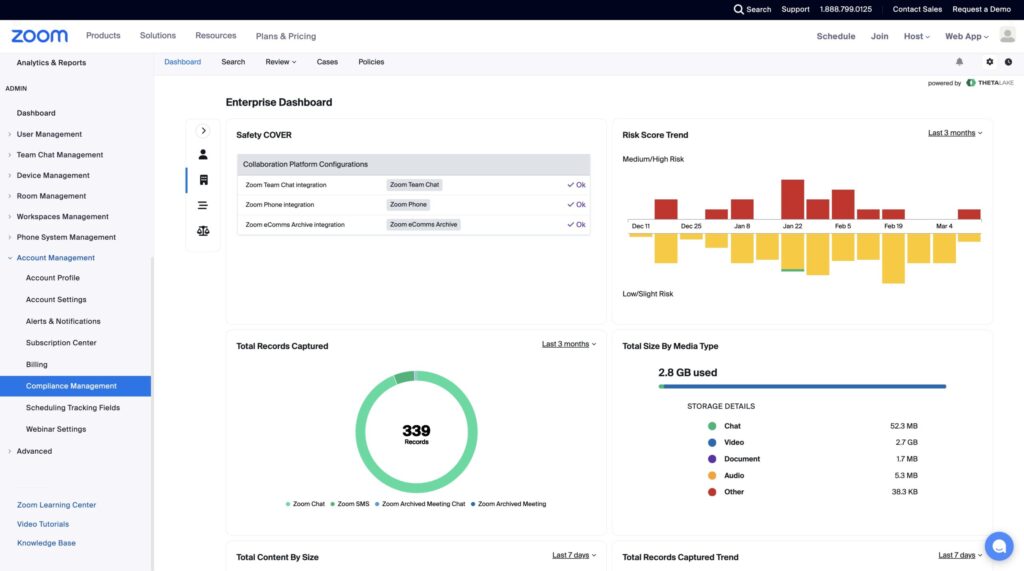Key takeaways
When it comes to selecting a VoIP solution for your business, the choice often narrows down to a few key players. Among these, Zoom and Skype are consistently top contenders. Both platforms offer features for video conferencing, chat, and integration with other business tools, but they also have unique strengths and weaknesses.
This article aims to provide a detailed comparison of Zoom and Skype, focusing on their capabilities, usability, integration options, and overall performance in various business scenarios. By the end of this comparison, you should have a clearer understanding of which platform aligns better with your business needs.
Zoom vs. Skype: A detailed comparison
Score
Best For
Key Differentiator
Pricing
Free Plan?

Zoom
4.25
Large-scale meetings and webinars
Advanced features like breakout rooms and integrations
Basic (Free), Pro ($15.99/month/user), Business ($21.99/month/user), Enterprise (Contact for pricing)
Yes

Skype
4.12
Integration with Microsoft Office ecosystem
Free Skype-to-Skype calling and competitive international rates
Free plan, Pay-As-You-Go, Subscription Plans: Unlimited US & Canada ($3.39/month), Unlimited North America ($5.94/month), Unlimited World ($11.89/month)
Yes

Zoom: Best for large-scale meetings and webinars
Overall Score
4.25/5
Pricing
3.44/5
General features and interface
4.42/5
Core VoIP features
4.58/5
Advanced features
3.5/5
Integration and compatibility
4.58/5
UX
4.69/5
Security and compliance
4.38/5
Customer support and service
4.25/5
Pros
- Broad integrations
- Strong security
- Extensive advanced features
- Up to 1,000 participants in meetings
- Up to 10,000 attendees in webinars
Cons
- 40-minute restriction in free tier
- Higher cost for premium features
Read more: 6 Best Zoom Alternatives of 2024

Skype: Best for Microsoft ecosystem integration
Overall Score
4.12/5
Pricing
3.22/5
General features and interface
4.15/5
Core VoIP features
3.8/5
Advanced features
3/5
Integration and compatibility
4.17/5
UX
3.8/5
Security and compliance
4.1/5
Customer support and service
4.25/5
Pros
- Easy to use
- Free plan available
- International calls at competitive rates
- Cross-platform compatibility
Cons
- Lacks advanced features like breakout rooms and extensive call management options
- Scalability issues
Read more: 6 Best Skype Alternatives of 2024
| Zoom | Skype | |
|---|---|---|
| Free Plan | Yes (40-minute meetings, up to 100 participants) | Yes (Unlimited Skype-to-Skype calls, instant messaging, basic video conferencing) |
| Basic Plan | Free | Free |
| Pro Plan | $13.32/month/user (annual billing) or $15.99/month/user | Not applicable (Skype does not have a direct equivalent for this tier) |
| Business Plan | $18.32/month/user (annual billing) or $21.99/month/user | No plan available |
| Enterprise Plan | Contact for pricing (up to 1,000 participants, unlimited cloud storage) | No plan |
| Unlimited US & Canada Plan | No plan available | $3.39/month |
| Unlimited North America Plan | No plan available | $5.94/month |
| Unlimited World Plan | No plan available | $11.89/month |
| Pay-As-You-Go | Not applicable | Based on usage (Skype Credit for calls to mobile and landline numbers) |
| Features in Paid Plans | Extended meeting durations (up to 30 hours), 5 GB cloud storage (Pro), up to 300 participants (Business), advanced admin controls, unlimited whiteboards, SSO, managed domains (Business), up to 1,000 participants (Enterprise), unlimited cloud storage (Enterprise), full-featured PBX (Enterprise) | Unlimited calls to designated regions (depending on the plan), integration with Microsoft Office, competitive international calling rates |
| Learn More | Zoom Pricing | Skype Pricing |
When you compare the pricing structures of Zoom and Skype, you’ll notice two distinct approaches tailored to different user needs and market segments.
If you’re looking for a platform suited for large-scale meetings and webinars, you might find Zoom’s fully stocked feature set and scalability appealing. Zoom offers a free plan ideal for basic video conferencing, with paid tiers ranging from the Pro plan at $13.32 per month per user (billed annually) to the Business plan at $18.32 per month per user (billed annually). These plans offer increasing capabilities, from extended meeting durations and cloud storage to support for larger participant numbers and advanced features.
For large corporations, Zoom provides an Enterprise plan with the most extensive features, though you’ll need to request pricing for this tier. Across various tiers, you’ll have access to features like HD video, breakout rooms, and strong security measures such as end-to-end encryption and meeting passwords.
On the other hand, if you’re already using Office 365 and Microsoft Teams, you might find Skype’s deep integration with the Microsoft ecosystem attractive. Skype offers a free plan that provides substantial value with features like high-definition video and audio calls, instant messaging, and screen sharing. It could be a cost-effective solution for your personal use or small business needs.
For those who frequently call mobile phones and landlines, Skype offers Pay-As-You-Go options and subscription plans. These range from the Unlimited US & Canada plan at $3.39 per month to the Unlimited World plan at $11.89 per month, offering affordable rates for international calling that could benefit your business if you have global clients.
Who wins?
Skype.
Skype offers a more affordable and straightforward pricing model, which could be advantageous if you’re running a small business or need budget-friendly options for international calling. Zoom, while generally more expensive, justifies its higher cost with a comprehensive suite of features that might better suit your needs if you’re managing a larger organization with extensive capabilities and integration requirements.
Call length and participant limits
Zoom offers a free plan that allows group meetings for up to 40 minutes with a maximum of 100 participants. Importantly, this 40-minute limit only applies to meetings with three or more participants; one-on-one calls have no time restrictions for Basic plan users. This makes Zoom an excellent choice for small group collaborations and individual conversations without time pressure.
For those needing longer meeting durations, Zoom’s Pro plan extends meetings to up to 30 hours. The Business and Enterprise plans further enhance participant limits and feature sets, supporting up to 1,000 participants and including advanced options like unlimited cloud storage and full-featured PBX systems for large-scale professional needs.
Skype provides more lenient call limits on its free tier. Skype users can enjoy unlimited calls for up to 50 participants, which is ideal for small to medium-sized business meetings involving multiple stakeholders. Group calls can last up to 24 hours, making Skype a practical option for extended discussions without the need for frequent reconnections.
Additionally, Skype supports up to 100 participants in group calls under its fair usage policy, allowing for broader inclusivity in larger meetings. This extended call duration and participant capacity, combined with features like screen sharing, file sharing, and call recordings, make Skype a versatile tool for both personal and business use.
Who wins?
Skype.
Skype has a more generous free plan, allowing unlimited calls with up to 50 participants and call durations of up to 24 hours. This flexibility makes Skype a more practical option for extended meetings and small to medium-sized group collaborations without the need for frequent reconnections. Zoom may be known for its higher participant capacity in its paid plans, but the 40-minute limit on group meetings in its free tier is a significant constraint for users seeking longer, uninterrupted sessions.
Zoom vs. Skype: Advanced features
Both platforms extend well beyond basic video calling, offering a variety of tools to enhance professional and personal use. Zoom’s advanced features are accessible through its paid plans, although the free version still provides essential functionalities like whiteboarding and instant meetings, which are ideal for quick, spontaneous collaborations.
If you upgrade to the Pro plan or beyond, you’ll unlock advanced user management, admin control tools, the ability to remove participants from calls, chat functionalities, and notifications. Also available are additional paid add-ons like extra cloud storage for recordings, the Call Me feature for automatic meeting start times, and toll-free numbers for participants to join via landline or mobile phones without extra charges. These features could be particularly useful if you’re managing a large organization.
Skype, however, integrates many advanced features within its free tier, making it a strong contender if you’re running a small business or need solutions for individual use. Skype’s recent introduction of instant meetings allows you to set up video calls without needing to sign in. It also offers free cloud storage for recorded video calls. Its live video transcription is particularly useful for conference calls and team meetings. This feature translates calls in real-time into 10 languages and supports up to 60 languages for chat, which could be invaluable if you’re working with international teams or multilingual clients.
Additionally, Skype allows you to buy credits or subscriptions for making affordable calls to landlines and mobile phones worldwide and purchase local telephone numbers to enhance accessibility and professionalism.
Who wins?
Zoom.
Zoom’s comprehensive suite of advanced features, particularly in its higher-tier plans and add-ons, makes it the winner for advanced features. If you’re managing a larger enterprise looking for full and customizable solutions, you’ll find Zoom’s extensive capabilities and scalability particularly beneficial.
Zoom vs. Skype: User experience
If you’re looking for a platform that’s easy to use right out of the gate, Zoom might be your go-to. You’ll appreciate how easy it is to set up and join meetings—often with just a single click. Whether you’re tech-savvy or not, you’ll likely find Zoom’s interface intuitive. Need to share your screen or create a breakout room? You’ll find these features readily accessible without having to dig through complex menus.
On the move? Zoom’s got you covered with a well-designed mobile app that’ll give you a consistent experience whether you’re on your desktop, smartphone, or tablet. And if you ever get stuck, you’ll have a wealth of support at your fingertips, from online help centers to live chat. If you’re a premium user, you can even shoot off an email for personalized support.
Now, if you’re already knee-deep in the Microsoft ecosystem, Skype might feel like a natural extension of your digital workspace. You’ll likely find its clean, straightforward interface familiar and easy to navigate. One of Skype’s standout features is its seamless integration with other Microsoft Office products. Imagine scheduling and joining calls directly from your Outlook email or calendar—pretty convenient, right?
Like Zoom, Skype plays nice with a variety of devices, so you can stay connected whether you’re at your desk or on the go. However, it’s worth noting that some users have reported occasional hiccups with lag and call quality, which might throw a wrench in your communication flow from time to time.
Who wins?
Zoom.
It’s a close call, but Zoom edges ahead with its streamlined interface and variety of support options. That said, if you’re heavily invested in Microsoft’s suite of tools, Skype’s integration might make it the more practical choice for your workflow.
Choosing the right video conferencing solution for your business
Each platform brings its own strengths to the table, and your choice will likely depend on what your specific needs are.
If you’re planning large-scale meetings or webinars, Zoom might be your go-to platform. With a solid rating of 4.25 out of 5, it’s clear that users are generally satisfied with what Zoom offers. One of its standout features is the ability to host up to 1,000 participants in a single meeting. However, keep in mind that to access these advanced features, you’ll need to opt for one of their paid plans.
Skype, while slightly behind with a 4.12 out of 5 rating, could still be the right option if your team already uses tools in the Microsoft Office ecosystem. One of Skype’s major selling points is its generous free plan. You can make unlimited calls with up to 50 participants without spending a dime. Plus, Skype throws in some impressive features, like free cloud storage for your recorded calls and real-time translation in 10 languages. If your business involves a lot of international communication, you might find Skype’s affordable international calling rates particularly appealing.
So, which one should you choose? Well, it really boils down to what you need. If you’re running a larger enterprise and need a platform that can handle extensive, feature-rich events with a large number of participants, Zoom might be your best bet. Its advanced features and scalability make it well-suited for complex business needs.
However, if you’re a small business owner or an individual user looking for a cost-effective solution that plays well with Microsoft Office, Skype could be the way to go. Its free plan offers a lot of value, and its integration with Microsoft tools could streamline your workflow significantly.
If neither option is right for your business, check out our comprehensive list of video conferencing options here: Best Video Conferencing Software for 2023.
















